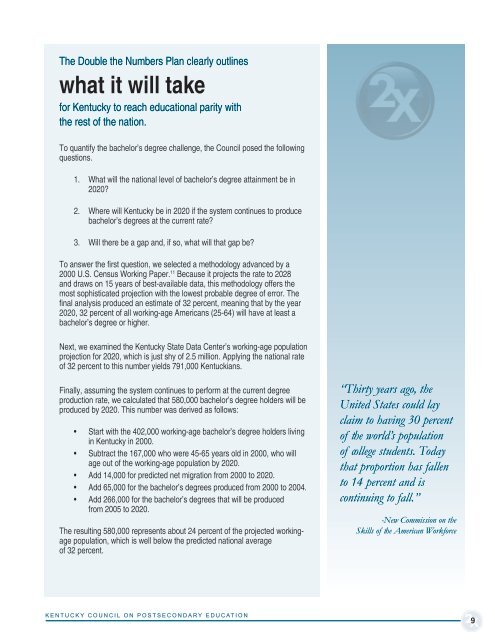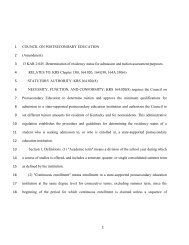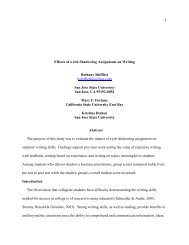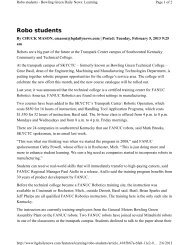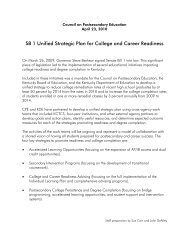Double the Numbers: Kentucky's Plan to Increase College Graduates
Double the Numbers: Kentucky's Plan to Increase College Graduates
Double the Numbers: Kentucky's Plan to Increase College Graduates
Create successful ePaper yourself
Turn your PDF publications into a flip-book with our unique Google optimized e-Paper software.
The <strong>Double</strong> <strong>the</strong> <strong>Numbers</strong> <strong>Plan</strong> clearly outlines<br />
what it will take<br />
for Kentucky <strong>to</strong> reach educational parity with<br />
<strong>the</strong> rest of <strong>the</strong> nation.<br />
To quantify <strong>the</strong> bachelor’s degree challenge, <strong>the</strong> Council posed <strong>the</strong> following<br />
questions.<br />
1.<br />
2.<br />
3.<br />
What will <strong>the</strong> national level of bachelor’s degree attainment be in<br />
2020?<br />
Where will Kentucky be in 2020 if <strong>the</strong> system continues <strong>to</strong> produce<br />
bachelor’s degrees at <strong>the</strong> current rate?<br />
Will <strong>the</strong>re be a gap and, if so, what will that gap be?<br />
To answer <strong>the</strong> first question, we selected a methodology advanced by a<br />
2000 U.S. Census Working Paper. 11 Because it projects <strong>the</strong> rate <strong>to</strong> 2028<br />
and draws on 15 years of best-available data, this methodology offers <strong>the</strong><br />
most sophisticated projection with <strong>the</strong> lowest probable degree of error. The<br />
final analysis produced an estimate of 32 percent, meaning that by <strong>the</strong> year<br />
2020, 32 percent of all working-age Americans (25-64) will have at least a<br />
bachelor’s degree or higher.<br />
Next, we examined <strong>the</strong> Kentucky State Data Center’s working-age population<br />
projection for 2020, which is just shy of 2.5 million. Applying <strong>the</strong> national rate<br />
of 32 percent <strong>to</strong> this number yields 791,000 Kentuckians.<br />
Finally, assuming <strong>the</strong> system continues <strong>to</strong> perform at <strong>the</strong> current degree<br />
production rate, we calculated that 580,000 bachelor’s degree holders will be<br />
produced by 2020. This number was derived as follows:<br />
• Start with <strong>the</strong> 402,000 working-age bachelor’s degree holders living<br />
in Kentucky in 2000.<br />
• Subtract <strong>the</strong> 167,000 who were 45-65 years old in 2000, who will<br />
age out of <strong>the</strong> working-age population by 2020.<br />
• Add 14,000 for predicted net migration from 2000 <strong>to</strong> 2020.<br />
• Add 65,000 for <strong>the</strong> bachelor’s degrees produced from 2000 <strong>to</strong> 2004.<br />
• Add 266,000 for <strong>the</strong> bachelor’s degrees that will be produced<br />
from 2005 <strong>to</strong> 2020.<br />
The resulting 580,000 represents about 24 percent of <strong>the</strong> projected workingage<br />
population, which is well below <strong>the</strong> predicted national average<br />
of 32 percent.<br />
“Thirty years ago, <strong>the</strong><br />
United States could lay<br />
claim <strong>to</strong> having 30 percent<br />
of <strong>the</strong> world’s population<br />
of college students. Today<br />
that proportion has fallen<br />
<strong>to</strong> 14 percent and is<br />
continuing <strong>to</strong> fall.”<br />
-New Commission on <strong>the</strong><br />
Skills of <strong>the</strong> American Workforce<br />
kentucky Council on Postsecondary Education<br />
9


